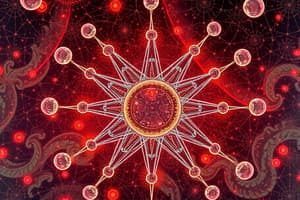Podcast
Questions and Answers
What is the composition of an atom's central nucleus?
What is the composition of an atom's central nucleus?
Protons and neutrons
Which part of an atom makes up almost all of its mass?
Which part of an atom makes up almost all of its mass?
The nucleus
How are atomic structure represented symbolically?
How are atomic structure represented symbolically?
Using atomic number and mass number
What are isotopes?
What are isotopes?
What distinguishes isotopes from each other?
What distinguishes isotopes from each other?
Give an example of two carbon isotopes and their neutron compositions.
Give an example of two carbon isotopes and their neutron compositions.
How do small variations in the number of neutrons affect isotopes in chemical reactions?
How do small variations in the number of neutrons affect isotopes in chemical reactions?
What crucial role do isotopes play in understanding radioactivity?
What crucial role do isotopes play in understanding radioactivity?
What typically results from the radioactive decay process in an atom's nucleus?
What typically results from the radioactive decay process in an atom's nucleus?
How do isotopes contribute to the concept of radioactivity?
How do isotopes contribute to the concept of radioactivity?
Study Notes
Atomic Physics: Understanding Atoms and Their Variations
Atomic Structure
An atom consists of a central nucleus, containing protons and neutrons, surrounded by electrons that orbit around it. The nucleus makes up almost all of an atom's mass, while electrons occupy most of its space. The structure of an atom can be represented symbolically using the atomic number (which indicates the number of protons in the nucleus) and the mass number (the sum of the number of protons and neutrons).
Isoopes
Isotopes are different forms of the same element that have the same number of protons but differ in the number of neutrons they possess. Two elements with different numbers of neutrons will have distinct masses. For example, carbon-12 has six protons and six neutrons, while carbon-14 has six protons and eight neutrons. These small variations in the number of neutrons do not significantly affect an element's chemical properties, making them indistinguishable in many reactions. However, isotopes play a crucial role in understanding radioactivity, which involves particles decaying from an atom's nucleus to reach a stable state. This radioactive decay process typically results in one element being converted into another element with different atomic mass numbers.
In summary, understanding the atomic structure and isotopes of elements allows scientists to study their properties and interactions, leading to advancements in various fields, including chemistry, nuclear physics, and materials science. While some isotopes may have significant uses in applications like dating fossils, others contribute to life-changing technologies such as medical imaging and cancer treatment.
Studying That Suits You
Use AI to generate personalized quizzes and flashcards to suit your learning preferences.
Description
Explore the fundamental concepts of atomic structure and isotopes, including the composition of atoms, roles of protons, neutrons, and electrons, and the significance of isotopic variations within elements. Learn about the implications of isotopes in various scientific disciplines and technological advancements.




